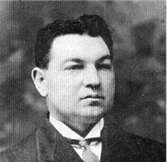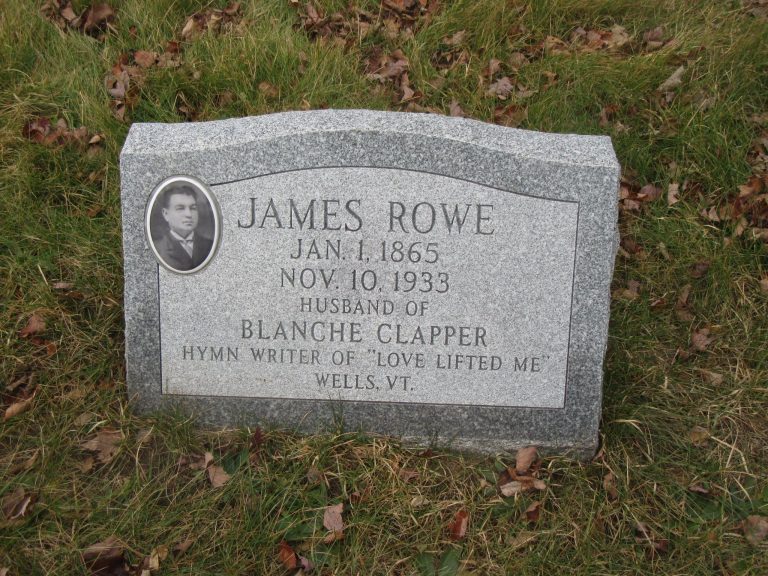Hymn History: Love Lifted Me & Author: James Rowe
“Poetry came easy to him.”
(Louise Rowe Mayhew)
The Origin of the Hymn “Love Lifted Me”
Few hymns capture the saving grace and redemptive power of Christ’s love as beautifully as “Love Lifted Me.” Its joyful declaration—“Love lifted me, when nothing else could help, love lifted me”—has been sung by generations of believers who found in its simple words a testimony of deliverance. The hymn was written in 1912 by James Rowe, with music composed by Howard E. Smith, and it quickly became one of the most beloved gospel songs of the twentieth century. Its message is both personal and universal: no matter how deep the waters of sin or despair, the love of Christ reaches down to lift the soul to safety and peace.
James Rowe: The Lyricist
James Rowe was born in 1865 in Devonshire, England. In his early years, he worked as a railway employee before immigrating to the United States in 1889. Settling first in Albany, New York, Rowe began a career as a government railway clerk, but his heart was drawn to writing. A gifted storyteller and poet, he eventually devoted himself full-time to writing gospel songs, hymns, and children’s verses.
Rowe became a prolific hymnwriter—by some estimates, he wrote over 9,000 texts during his lifetime. His hymns often emphasized the love of God, the joy of salvation, and the assurance of Christ’s presence in daily life. Among his other well-known works are “I Choose Jesus,” “Speak a Good Word for Jesus,” and “I Would Be Like Jesus.”
By 1912, Rowe was collaborating with several gospel musicians, including Howard E. Smith, a fellow believer who shared his passion for evangelistic music. Their partnership would soon produce one of the most enduring hymns of the modern church.
Howard E. Smith: The Composer
Howard E. Smith was born in 1863 in Connecticut and served as a church musician and organist in small-town congregations. Though little is recorded about his personal life, Smith was known for his deep faith and musical sensitivity. At the time he worked with Rowe, Smith was serving as the organist for the Methodist church in Madison, Connecticut.
According to hymn historians, Smith was partially disabled, making his ability to play and compose all the more remarkable. When Rowe sent him the text for “Love Lifted Me,” Smith reportedly composed the tune from his home organ, with Rowe by his side to assist and encourage him as they worked together line by line.
The Inspiration and Biblical Foundation
The inspiration for “Love Lifted Me” comes from the Gospel story of Jesus calming the storm, particularly Matthew 14:29–31, where Peter walks on the water toward Jesus:
“And when Peter was come down out of the ship, he walked on the water, to go to Jesus. But when he saw the wind boisterous, he was afraid; and beginning to sink, he cried, saying, Lord, save me. And immediately Jesus stretched forth his hand, and caught him.”
Rowe imagined Peter’s cry and the Savior’s response as a symbol of every believer’s experience. Just as Christ lifted Peter from the stormy sea, so His love lifts the sinner from the depths of sin and despair. This theme runs throughout the hymn’s three stanzas.
The first verse vividly pictures the lost sinner:
I was sinking deep in sin,
Far from the peaceful shore,
Very deeply stained within,
Sinking to rise no more;
But then, the turning point comes:
But the Master of the sea
Heard my despairing cry,
From the waters lifted me,
Now safe am I.
The refrain—“Love lifted me!”—is a triumphant shout of salvation, echoing the joy of one who has been rescued by divine grace. The subsequent verses build on this image, describing the believer’s response: loving devotion, faithfulness, and service to the One who saved them.
Publication and Popular Reception
“Love Lifted Me” was first published in 1912 in Songs of Praise and Power, a collection compiled by Rowe and other gospel writers of the era. From the beginning, it found a ready audience among revivalists, Sunday schools, and rural congregations who loved its clear message and memorable melody.
Its strong, rolling rhythm—often likened to the motion of waves—made it a natural favorite for congregational singing. The refrain was especially easy for children to remember, making the hymn a mainstay in Sunday school programs and evangelistic meetings.
By the mid-20th century, “Love Lifted Me” appeared in nearly every major Protestant hymnal. It became one of the defining gospel hymns of its generation, embodying the warmth and simplicity that characterized early 1900s American gospel music.
Enduring Legacy
The enduring appeal of “Love Lifted Me” lies in its timeless message. Though the language and style reflect the gospel tradition of the early 1900s, its spiritual truth remains relevant: salvation is an act of divine love.
For many Christians, the hymn also carries personal associations. It has been sung at baptisms, revivals, and funerals—moments of both joy and reflection. Its emphasis on the saving power of Christ’s love continues to comfort hearts and inspire renewed faith.
Contemporary artists have also revisited the hymn. In 1970, country singer Kenny Rogers recorded a version of “Love Lifted Me,” bringing it to a wider audience while maintaining its spiritual core. Yet in churches around the world, the traditional form of the hymn remains the most beloved.
A Song of Salvation and Gratitude
When James Rowe and Howard E. Smith composed “Love Lifted Me,” they may not have realized how far their song would travel. Born from the collaboration of two humble servants of God, it has since lifted the hearts of millions.
In its simple melody and heartfelt words, the hymn expresses the essence of the Christian testimony—once lost, now found; once sinking, now lifted by love divine. As long as believers continue to sing of God’s saving grace, the refrain will ring true through the ages:
Love lifted me! Love lifted me!
hen nothing else could help,
Love lifted me!
Related
Sorry, no records were found. Please adjust your search criteria and try again.
Sorry, unable to load the Maps API.

